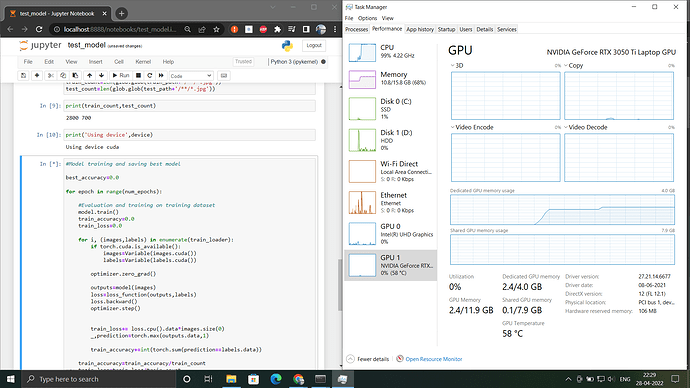I am not able you completely run on GPU or Run only on GPU
I am Building a own classifier model and the code is running on both GPU and CPU together
import os
import numpy as np
import torch
import glob
import torch.nn as nn
import torchvision
from torchvision.transforms import transforms
from torch.utils.data import DataLoader
import torch.optim as optim
from torch.autograd import Variable
import torchvision
import pathlib
import os, os.path
device = torch.device('cuda' if torch.cuda.is_available() else 'cpu')
print('Using device',device)
> Using device cuda
transformer=transforms.Compose([
transforms.Resize((256,256)),
transforms.RandomHorizontalFlip(),
transforms.ToTensor(),
transforms.Normalize([0.485, 0.456, 0.406],
[0.229, 0.224, 0.225])
])
train_path = 'D:/Anaconda Environment/Object Detection Pytorch/Classification/data4/train'
test_path = 'D:/Anaconda Environment/Object Detection Pytorch/Classification/data4/val'
train_loader = DataLoader(
torchvision.datasets.ImageFolder(train_path, transform=transformer),
batch_size=16, shuffle=True
)
test_loader = DataLoader(
torchvision.datasets.ImageFolder(train_path, transform=transformer),
batch_size=16, shuffle=True
)
root=pathlib.Path(train_path)
classes=sorted([j.name.split('/')[-1] for j in root.iterdir()])
print(classes)
class Net(nn.Module):
def __init__(self,num_classes):
super(Net,self).__init__()
#Input Image = (64,3,256,256)
self.conv1=nn.Conv2d(in_channels=3,out_channels=12,kernel_size=3,stride=1,padding=1)
#output(64,12,256,256)
self.bn1=nn.BatchNorm2d(num_features=12)
#output = (64,12,256,256)
self.relu1 = nn.ReLU()
#Output = (64,12,256,256)
self.pool=nn.MaxPool2d(kernel_size=2)
#Output = (64,12,128,128)
self.conv2=nn.Conv2d(in_channels=12,out_channels=24,kernel_size=3,stride=1,padding=1)
#output(64,24,128,128)
#output = (64,24,256,256)
self.relu2 = nn.ReLU()
self.conv3=nn.Conv2d(in_channels=24,out_channels=48,kernel_size=3,stride=1,padding=1)
#output(64,12,256,256)
self.bn2=nn.BatchNorm2d(num_features=48)
#output = (64,12,256,256)
self.relu3 = nn.ReLU()
self.pool=nn.MaxPool2d(kernel_size=2)
#Output = (64,36,64,64)
self.conv4=nn.Conv2d(in_channels=48,out_channels=96,kernel_size=3,stride=1,padding=1)
#output(64,12,256,256)
self.bn3=nn.BatchNorm2d(num_features=96)
#output = (64,12,256,256)
self.relu4 = nn.ReLU()
self.fc=nn.Linear(in_features =32*32*96,out_features=num_classes)
def forward(self,input):
output=self.conv1(input)
output=self.bn1(output)
output=self.relu1(output)
output=self.pool(output)
output=self.conv2(output)
output=self.relu2(output)
output=self.pool(output)
output=self.conv3(output)
output=self.bn2(output)
output=self.relu3(output)
output=self.conv4(output)
output=self.bn3(output)
output=self.relu4(output)
output=self.pool(output)
output=output.view(-1,32*32*96)
output=self.fc(output)
return output
model = Net(num_classes=7).to(device)
#Optimizer and Loss Function
optimizer = optim.SGD(model.parameters(),lr=0.001, weight_decay=0.001)
loss_function=nn.CrossEntropyLoss()
num_epochs = 25
#calculating the size of training and testing images
train_count=len(glob.glob(train_path+'/**/*.jpg'))
test_count=len(glob.glob(test_path+'/**/*.jpg'))
#Model training and saving best model
best_accuracy=0.0
for epoch in range(num_epochs):
#Evaluation and training on training dataset
model.train()
train_accuracy=0.0
train_loss=0.0
for i, (images,labels) in enumerate(train_loader):
if torch.cuda.is_available():
images=Variable(images.cuda())
labels=Variable(labels.cuda())
optimizer.zero_grad()
outputs=model(images)
loss=loss_function(outputs,labels)
loss.backward()
optimizer.step()
train_loss+= loss.cpu().data*images.size(0)
_,prediction=torch.max(outputs.data,1)
train_accuracy+=int(torch.sum(prediction==labels.data))
train_accuracy=train_accuracy/train_count
train_loss=train_loss/train_count
# Evaluation on testing dataset
model.eval()
test_accuracy=0.0
for i, (images,labels) in enumerate(test_loader):
if torch.cuda.is_available():
images=Variable(images.cuda())
labels=Variable(labels.cuda())
outputs=model(images)
_,prediction=torch.max(outputs.data,1)
test_accuracy+=int(torch.sum(prediction==labels.data))
test_accuracy=test_accuracy/test_count
print('Epoch: '+str(epoch)+' Train Loss: '+str(train_loss)+' Train Accuracy: '+str(train_accuracy)+' Test Accuracy: '+str(test_accuracy))
#Save the best model
if test_accuracy>best_accuracy:
torch.save(model.state_dict(),'best_checkpoint.model')
best_accuracy=test_accuracy
This is the code that i am working on
can anyone help me with these
You can see in the screen shot that both my CPU and GPU are getting utilized in the execution of the program.

